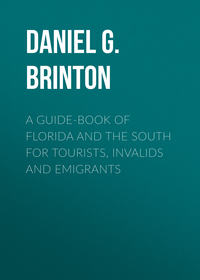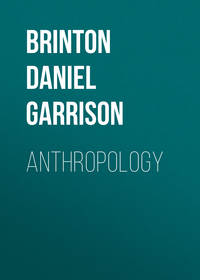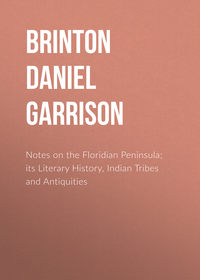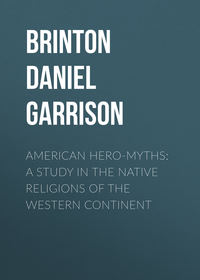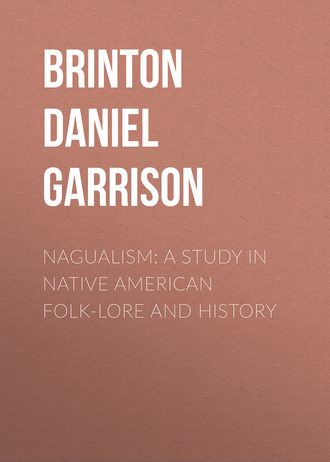 полная версия
полная версияNagualism: A Study in Native American Folk-lore and History
The rituals and prayers of the nagualists bear witness to this. It is very visible in those I have quoted from Nuñez de la Vega, and I can add an interesting example of it which has not heretofore been published. I take it from the MSS. of Father Vicente Hernandez Spina, cura of Ixtlavacan, in Guatemala, a remote village of the Quiches. He wrote it down in the native tongue about forty years ago, as recited by an ah-kih, “reader of days,” a native master of the genethliac art, who had composed it in favor of a client who had asked his intercession.
Prayer of an Ah-Kih“O Jesus Christ my God: thou God the Son, with the Father and the Holy Spirit, art my only God. Today, on this day, at this hour, on this day Tihax, I call upon the holy souls which accompany the sun-rising and the sun-setting of the day: with these holy souls I call upon thee, O chief of the genii, thou who dwellest in this mountain of Siba Raxquin; come, ye holy spirits of Juan Vachiac, of Don Domingo Vachiac, of Juan Ixquiaptap, the holy souls of Francisco Excoquieh, of Diego Soom, of Juan Fay, of Alonzo Tzep; I call the holy souls of Diego Tziquin and of Don Pedro Noh: you, O priests, to whom all things are revealed, and thou, chief of the genii, you, lords of the mountains, lords of the plains, thou, Don Purupeto Martin, come, accept this incense, accept to-day this candle.129
“Come also, my mother Holy Mary, the Lord of Esquipulas, the Lord of Capetagua, the beloved Mary of Chiantla, with her who dwells at San Lorenzo, and also Mary of Sorrows, Mary Saint Anna, Mary Tibureia, Mary of Carmen, with Saint Michael the Archangel, the captain St. James, St. Christoval, St. Sebastian, St. Nicolas, St. Bonaventura, St. Bernardin, St. Andrew, St. Thomas, St. Bartholomew, and thou my beloved mother St. Catherine, thou beloved Mary of the Conception, Mary of the Rosary, thou lord and king Pascual, be here present.
“And thou, Frost, and thou, excellent Wind, thou, God of the plain, thou, God of Quiac-Basulup, thou, God of Retal-Uleu, thou, lord of San Gregorio, thou, lord of Chii-Masa. [These are mountains and localities, and in the original there follow the names of more than a hundred others. The prayer concludes as follows:]
“… I who appoint myself godfather and godmother, I who ask, I the witness and brother of this man who asks, of this man who makes himself, your son, O holy souls, I ask, do not let any evil happen unto him, nor let him be unhappy for any cause.
“I the priest, I who speak, I who burn this incense, I who light this candle, I who pray for him, I who take him under my protection, I ask you that he may obtain his subsistence with facility. Thou, God, canst provide him with money; let him not fall ill of fever; I ask that he shall not become paralytic; that he may not choke with severe coughing; that he be not bitten by a serpent; that he become neither bloated nor asthmatic; that he do not go mad; that he be not bitten by a dog; that he be not struck by lightning; that he be not choked with brandy; that he be not killed with iron, nor by a stick, and that he be not carried off by an eagle; guard him, O clouds; aid him, O lightning; aid him, O thunder; aid him, St. Peter; aid him, St. Paul; aid him, eternal Father.
“And I who up to this time have spoken for him to you, I ask you that sickness may visit his enemies. So order it, that when his enemies go forth from their houses, they may meet sickness; order it, that wherever they go, they may meet troubles; do your offices of injury to them, wheresoever they are met; do this that I pray, O holy souls. God be with you; God the Father, God the Son, God the Holy Spirit: Amen, Jesus.”
Most of such invocations are expressed in terms far more recondite and symbolic than the above. We have many such preserved in the work of Jacinto de la Serna, which supply ample material to acquaint us with the peculiarities of the sacred and secret language of the nagualists. I shall quote but one, that employed in the curious ceremony of “calling back the tonal,” referred to on a previous page. I append an explanation of its obscure metaphors.
Invocation for the Restitution of the Tonal“Ho there! Come to my aid, mother mine of the skirt of precious stones!130 What keeps thee away, gray ghost, white ghost?131 Is the obstacle white, or is it yellow? See, I place here the yellow enchantment and the white enchantment.132
“I, the Master of the Masters of enchantments, have come, I, who formed thee and gave thee life.133 Thou, mother mine of the starry skirt, thou, goddess of the stars, who givest life, why hast thou turned against this one?134
“Adverse spirit and darkened star, I shall sink thee in the breadth and depth of the waters.135 I, master of spells, speak to thee Ho there! Mother mine, whose skirt is made of gems, come, seek with me the shining spirit who dwells in the house of light,136 that we may know what god or mighty power thus destroys and crushes to earth this unfortunate one. Green and black spirit of sickness, leave him and seek thy prey elsewhere.
“Green and yellow ghost, who art wandering, as if lost, over mountains and plains, I seek thee, I desire thee; return to him whom thou hast abandoned. Thou, the nine times beaten, the nine times smitten, see that thou fail me not.137 Come hither, mother mine, whose robe is of precious gems; one water, two waters; one rabbit, two rabbits; one deer, two deers; one alligator, two alligators.138
“Lo! I myself am here; I am most furious; I make the loudest noise of all; I respect no one; even sticks and stones tremble before me. What god or mighty power dare face me, me, a child of gods and goddesses?139 I have come to seek and call back the tonal of this sick one, wherever it is, whithersoever it has wandered, be it nine times wandered, even unto the nine junctures and the nine unions.140 Wherever it is, I summon it to return, I order it to return, and to heal and clean this heart and this head.”
Explanations1. The appeal is to Water, regarded as the universal Mother. The “skirt of precious stones” refers to the green of the precious green stones, a color sacred to water.
2. The question is addressed to the tonal.
3. The yellow enchantment is tobacco; the white, a cup of water.
4. That is, assigned the form of the nagual belonging to the sick man.
5. This appeal is directed to the Milky Way.
6. The threat is addressed to the tonal, to frighten it into returning.
7. The “shining spirit” is the Fire-god.
8. The yellow tobacco, prepared ceremonially in the manner indicated.
9. These are names of days in the native calendar which are invoked.
10. The priest speaks in the person of his god.
11. Referring to the Nahuatl belief that there are nine upper and nine under worlds.
From the same work of de la Serna I collect the following list of symbolic expressions. It might easily be extended, but these will be sufficient to show the figurative obscurities which they threw around their formulas of conjuration, but which were by no means devoid of coherence and instruction to those who could understand them.
Symbolic Expressions of the NagualistsBlood.– “The red woman with snakes on her gown” (referring to the veins).
Copal Gum.– “The white woman” (from the whitish color of the fresh gum).
Cords (for carrying burdens). – “The snake that does woman’s work” (because women sit still to knit, and the cord works while itself is carried).
Drunkenness.– “My resting time,” or “when I am getting my breath.”
The Earth.– “The mirror that smokes” (because of the mists that rise from it); “the rabbit with its mouth upward” (the rabbit, in opposition to the one they see in the moon; with its mouth upward, because of the mists which rise from it like the breath exhaled from the mouth); “the flower which contains everything” (as all fruit proceeds from flowers, so does all vegetable life proceed from the earth, which is therefore spoken of as a flower); “the flower which bites the mouths” (a flower, for the reason given; it eats the mouths, because all things necessarily return to it, and are swallowed by it).
Fingers.– “The five fates,” or “the five works,” or “the five fields” (because by the use of his fingers man works out his own destiny. Hence also the worship of the Hand among the Nahuas as the god Maitl, and among the Mayas as the god Kab, both which words mean “hand”).
Fire.– “Our Father of the Four Reeds” (because the ceremony of making the new fire was held on the day Four Reeds, 4 Acatl); “the shining rose;” “the yellow flyer;” “the red-haired one;” “the yellow spirit.”
A Knife of Copper.– “The yellow Chichimec” (because the Chichimecs were alleged to tear out the bowels of their enemies).
The Maguey Plant.– “My sister, the eight in a row” (because it was planted in this manner).
A Road.– “That which is divided in two, and yet has neither beginning, middle nor end” (because it always lies in two directions from a person, and yet all roads lead into others and thus never end).
Sickness.– “The red woman;” “the breath of the flame;” “our mother the comet” (all referring to the fever); “the Chichimec” (because it aims to destroy life, like these savage warriors); “the spider” (because of its venomous nature).
Smoke.– “The old wife” (i. e., of the fire).
The Sun.– “Our holy and pockified Uncle” (referring to the myth of Nanahuatl, who was syphilitic, and leaping into the flames of a fire rose as the sun).
Tobacco.– “The nine (or seven) times beaten” (because for sacred purposes it was rubbed up this number of times); “the enchanted gray one” (from its color and use in conjuring).
Water.– “The Green Woman” (from the greenness which follows moisture); “our Mother, whose robe is of precious stones” (from the green or vegetable life resembling the turquoise, emerald, jade, etc.).
36. It might be asked how the dark arts and secret ceremonies of the Nagualists escaped the prying eyes of the officers of the Holy Inquisition, which was established in Mexico in 1571. The answer is, that the inquisitors were instructed by Cardinal Diego de Espinosa, who at that time was Inquisitor General and President of the Council of the Indies, “to abstain from proceedings against Indians, because of their stupidity and incapacity, as well as scant instruction in the Holy Catholic faith, for the crimes of heresy, apostasy, heretical blasphemy, sorcery, incantations, superstitions,” etc.
Energetic inquisitors, however, conceded very grudgingly this exemption. In the imposing auto de fé celebrated in the city of Mexico, in 1659, a half-breed, Bernardo del Carpio by name, son of a full-blood Indian mother, accused of blasphemy, etc., endeavored to escape the Holy Office by pleading his Indian blood; but his appeal was disallowed, and the precedent established that any admixture whatever of European blood brought the accused within the jurisdiction of the Inquisition.141 Even this seems to have been a concession, for we find the record of an auto de fé held in 1609, in the province of Tehuantepec, in which eight full-blood natives were punished for worshiping the goddess Pinopiaa.142 Mr. David Ferguson, however, who has studied extensively the records of the inquisition in Mexico, informs me that in none of the trials read by him has he observed any charges of Nagualism, although many white persons were accused, and some tried, for consulting Indian sorcerers.
37. It will be seen from what I have said, that the rites of Nagualism extended as widely as did the term over Mexico and Central America. It becomes, therefore, of importance to discover from what linguistic stock this term and its associated words are derived. From that source it is reasonable to suppose the rites of this superstition also had their origin.
The opinions on this subject have been diverse and positive. Most writers have assumed that it is a Nahuatl, or pure Mexican, word; while an eminent authority, Dr. Stoll, is not less certain that it is from a radical belonging to the neighboring great stock of the Mayan dialects, and especially the Quiche, of Guatemala.143 Perhaps both these positions are erroneous, and we must look elsewhere for the true etymology of these expressions. Unquestionably they had become domesticated in both Maya and Nahuatl; but there is some reason to think they were loan-words, belonging to another, and perhaps more venerable, civilization than either of these nations could claim.
To illustrate this I shall subjoin several series of words derived from the same radical which is at the basis of the word nagual, the series, three in number, being taken from the three radically diverse, though geographically contiguous, linguistic stocks, the Maya, the Zapotec and the Nahuatl.
From the Maya, of YucatanNaual, or nautal, a native dance, forbidden by the missionaries.
Naatil, talent, skill, ability.
Naat, intelligence, wisdom.
Naatah, to understand, to divine.
Nanaol, to consider, to contemplate, to meditate, to commune with oneself, to enter into oneself.
Noh, great, skillful; as noh ahceh, a skillful hunter.
From Maya DialectsQuiche-CakchiquelNaual, a witch or sorcerer.
Naualin, to tell fortunes, to predict the future.
Qui naualin, to sacrifice, to offer sacrifices.
Na, to feel, to suspect, to divine, to think in one’s heart.
Nao, to know, to be alert or expert in something.
Naol, a skillful person, a rhetorician.
Naotizan, to make another intelligent or astute.
Natal, the memory.
Natub, the soul or shadow of a man.
Noh, the god of reason (“Genius der Vernunft,” Scherzer).
Noh, to fecundate, to impregnate (Popol Vuh).
TzentalX-qna, to know.
X-qnaulai, to know often or thoroughly (frequentative).
Naom, wise, astute (naom vinic, hombre sabio).
Naoghi, art, science.
Naoghibal, memory.
Ghnaoghel, a wise man.
Alaghom naom, the Goddess of Wisdom.
From the Zapotec, of OaxacaNana, gana, gona, to know.
Nona, to know thoroughly, to retain in the memory.
Nana ticha, or nona lii, a wise man.
Guela nana, or guela nona, wisdom, knowledge.
Hue gona, or ro gona, a teacher, a master.
Na lii, truth; ni na lii, that which is true.
Naciña, or naciina, skill, dexterity.
Hui naa, a medicine man, a “nagualist.”
Nahaa, to speak pleasantly or agreeably.
Nayaa, or nayapi, to speak easily or fluently.
Rigoo gona, to sacrifice, to offer sacrifice.
Ni nana, the understanding, the intelligence, generally.
Nayanii, the superior reason of man.

Naua, to dance, holding each other by the hands.
Naualli, a sorcerer, magician, enchanter.
Nauallotl, magic, enchantment, witchcraft.
Nauatl, or nahuatl, skillful, astute, smart; hence, superior; applied to language, clear, well-sounding, whence (perhaps) the name of the tongue.
Nauati, to speak clearly and distinctly.
Nauatlato, an interpreter.
38. I believe that no one can carefully examine these lists of words, all taken from authorities well acquainted with the several tongues, and writing when they still retained their original purity, without acknowledging that the same radical or syllable underlies them all; and further, that from the primitive form and rich development of this radical in the Zapotec, it looks as if we must turn to it to recognize the origin of all these expressions, both in the Nahuatl and the Maya linguistic stocks.
The root na, to know, is the primitive monosyllabic stem to which we trace all of them. Nahual means knowledge, especially mystic knowledge, the Gnosis, the knowledge of the hidden and secret things of nature; easily enough confounded in uncultivated minds with sorcery and magic.144
It is very significant that neither the radical na nor any of its derivatives are found in the Huasteca dialect of the Mayan tongue, which was spoken about Tampico, far removed from other members of the stock. The inference is that in the southern dialects it was a borrowed stem.
Nor in the Nahuatl language – although its very name is derived from it145– does the radical na appear in its simplicity and true significance. To the Nahuas, also, it must have been a loan.
It is true that de la Serna derives the Mexican naualli, a sorcerer, from the verb nahualtia, to mask or disguise oneself, “because a naualli is one who masks or disguises himself under the form of some lower animal, which is his nagual;”146 but it is altogether likely that nahualtia derived its meaning from the custom of the medicine men to wear masks during their ceremonies.
Therefore, if the term nagual, and many of its associates and derivatives, were at first borrowed from the Zapotec language, a necessary corrollary of this conclusion is, that along with these terms came most of the superstitions, rites and beliefs to which they allude; which thus became grafted on the general tendency to such superstitions existing everywhere and at all times in the human mind.
Along with the names of the days and the hieroglyphs which mark them, and the complicated arithmetical methods by means of which they were employed, were carried most of the doctrines of the Nagualists, and the name by which they in time became known from central Mexico quite to Nicaragua and beyond.
The mysterious words have now, indeed, lost much of their ancient significance. In a recent dictionary of the Spanish of Mexico nagual is defined as “a witch; a word used to frighten children and make them behave,”147 while in Nicaragua, where the former Nahuatl population has left so many traces of its presence in the language of to-day, the word nagual no longer means an actor in the black art, or a knowledge of it, but his or her armamentarium, or the box, jar or case in which are kept the professional apparatus, the talismans and charms, which constitute the stock in trade or outfit of the necromancer.148
Among the Lacandons, of Mayan stock, who inhabit the forests on the upper waters of the Usumacinta river, at the present day the term naguate or nagutlat is said to be applied to any one “who is entitled to respect and obedience by age and merit;”149 but in all probability he is also believed to possess superior and occult knowledge.
39. All who have any acquaintance with the folk-lore of the world are aware that the notion of men and women having the power to change themselves into beasts is as wide as superstition itself and older than history. It is mentioned in the pages of Herodotus and in the myths of ancient Assyria. It is the property of African negroes, and the peasantry of Europe still hold to their faith in the reality of the were-wolf of Germany, the loup-garou of France and the lupo mannaro of Italy. Dr. Richard Andrée well says in his interesting study of the subject: “He who would explain the origin of this strange superstition must not approach it as a national or local manifestation, but as one universal in its nature; not as the property of one race or family, but of the species and its psychology at large.”150
Even in such a detail as the direct connection of the name of the person with his power of change do we find extraordinary parallelisms between the superstition of the red man of America and the peasant of Germany. As in Mexico the nagual was assigned to the infant by a form of baptism, so in Europe the peasants of east Prussia hold that if the godparent at the time of naming and baptism thinks of a wolf, the infant will acquire the power of becoming one; and in Hesse to pronounce the name of the person in the presence of the animal into which he has been changed will restore him to human shape.151
40. I need not say that the doctrine of personal spirits is not especially Mexican, nor yet American; it belongs to man in general, and can be recognized in most religions and many philosophies. In ancient Greece both the Platonicians and later the Neo-Platonicians thought that each individual has a particular spirit, or daimōn, in whom is enshrined his or her moral personality. To this daimōn he should address his prayers, and should listen heedfully to those interior promptings which seem to arise in the mind from some unseen silent monitor.152
Many a member of the Church of Rome substitutes for the daimōn of the Platonists the patron saint after whom he is named, or whom he has chosen from the calendar, the hagiology, of his Church. This analogy did not fail to strike the early missionaries, and they saw in the Indian priest selecting the nagual of the child a hideous and diabolical caricature of the holy rites.
But what was their horror when they found that the similarity proceeded so far that the pagan priest also performed a kind of baptismal sacrament with water; and that in the Mexican picture-writing the sign which represents the natal day, the tonal, by which the individual demon is denoted, was none other than the sign of the cross, as we have seen. This left no doubt as to the devilish origin of the whole business, which was further supported by the wondrous thaumaturgic powers of its professors.
41. How are we to explain these marvelous statements? It will not do to take the short and easy road of saying they are all lies and frauds. The evidence is too abundant for us to doubt that there was skillful jugglery among the proficients in the occult arts among those nations. They could rival their colleagues in the East Indies and Europe, if not surpass them.
Moreover, is there anything incredible in the reports of the spectators? Are we not familiar with the hypnotic or mesmeric conditions in which the subject sees, hears and feels just what the master tells him to feel and see? The tricks of cutting oneself or others, of swallowing broken glass, of handling venomous reptiles, are well-known performances of the sect of the Aissaoua in northern Africa, and nowadays one does not have to go off the boulevards of Paris to see them repeated. The phenomena of thought transference, of telepathy, of clairvoyance, of spiritual rappings, do but reiterate under the clear light of the close of the nineteenth century the mystical thaumaturgy with which these children of nature were familiar centuries ago in the New World, and which are recorded of the theosophists and magicians of Egypt, Greece and Rome.153 So long as many intelligent and sensible people among ourselves find all explanations of these modern phenomena inadequate and unsatisfactory, we may patiently wait for a complete solution of those of a greater antiquity.
42. The conclusion to which this study of Nagualism leads is, that it was not merely the belief in a personal guardian spirit, as some have asserted; not merely a survival of fragments of the ancient heathenism, more or less diluted by Christian teachings, as others have maintained; but that above and beyond these, it was a powerful secret organization, extending over a wide area, including members of different languages and varying culture, bound together by mystic rites, by necromantic powers and occult doctrines; but, more than all, by one intense emotion – hatred of the whites – and by one unalterable purpose – that of their destruction, and with them the annihilation of the government and religion which they had introduced.
1
These words occur a number of times in the English translation, published at London in 1822, of Dr. Paul Felix Cabrera’s Teatro Critico Americano. The form nagual instead of nahual, or naual, or nawal has been generally adopted and should be preferred.






